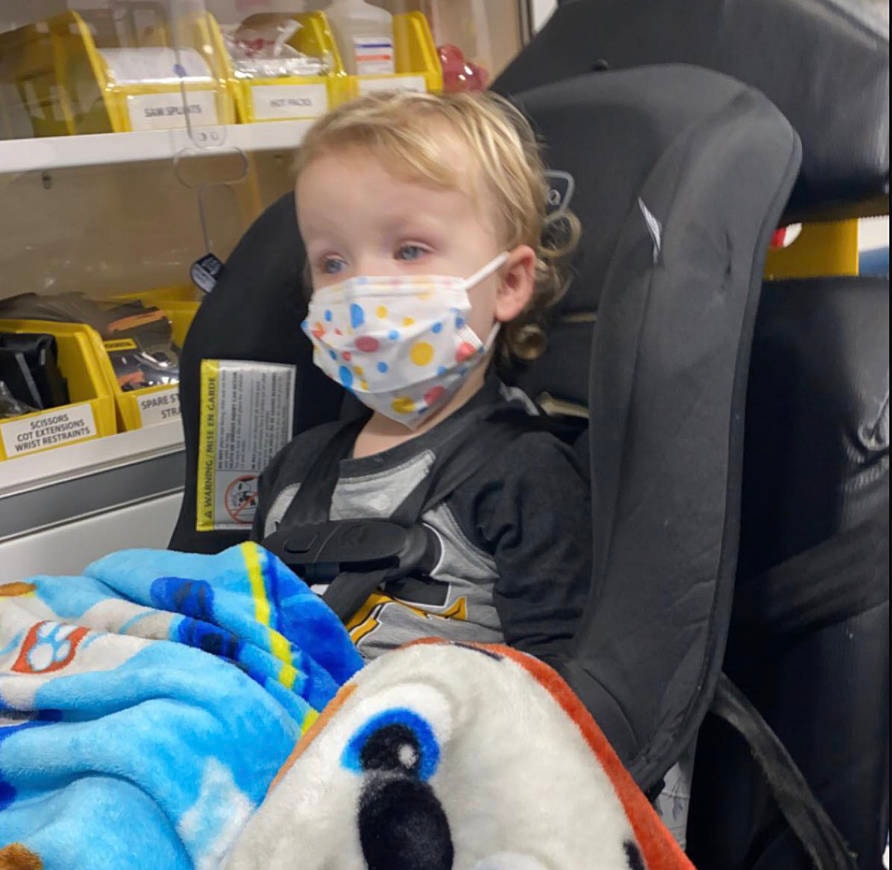By Baneet Braich, Contributor
Two-year-old Milo Coughlan woke up from his Sunday nap looking groggy.
Half an hour later, Milo was shaking on the couch. His complexion turned completely pale and his lips turned blue.
He soon became unresponsive to his mother’s voice.
“He was completely limp. He just wasn’t arousing at all,” said Milo’s mother, Alexis Coughlan.
Twelve minutes passed until the paramedics arrived to assist the toddler, who had a seizure.
For Coughlan, 12 minutes felt eternal. She questions why the paramedics took so long and why the firefighters from down the street were not dispatched.
BC Emergency Health Services (BCEHS) told The Abbotsford News that Coughlan’s call did not qualify for a fire-first responder notification.
“There was absolutely no delay in response on this call,” said BCEHS spokesperson Shannon Miller.
Coughlan said she is frustrated that her son’s condition did not qualify for firefighters to arrive on scene.
“What’s the point of full-time firefighters in the city for emergencies?” she said. “There’s a hall around the corner. They would have been here in two minutes able to provide some sort of medical help.”
As of May 30, 2018, BCEHS has updated the Clinical Response Model system for how it assigns paramedics, ambulances and other resources to 911 calls using a colour-coding system.
RELATED: Dispatch firefighters to more medical calls, urge Metro Vancouver mayors
BCEHS said firefighters are only notified of medical emergency calls when the code is red or purple for immediate life-threatening calls.
Milo’s case was coded orange, meaning urgent but not an immediately life-threatening condition such as abdominal pain. BCEHS said notifying firefighters to attend code-orange calls depends on many varying factors.
“In rural and remote communities, paramedics can take longer to reach patients and sometimes where there are longer response times firefighters are notified,” Miller said.
The pandemic has also reduced the number of lower acuity calls that firefighters can attend to reduce the risk of infection. For privacy reasons, BCEHS did not clarify specific details of why Milo’s case was coded as orange.
Coughlan is a nurse and her husband is an on-call firefighter. Despite both being medical professionals, Coughlan said having support from firefighters could have eased their anxiety.
“It was actually traumatizing to see your child like that, and to just be waiting and waiting for help, not knowing when it was going to get here.”
The B.C. Office of the Auditor General released a 2019 report on access to emergency services which found that BCEHS didn’t consistently meet its targets for timely quality care.
Ambulances met their nine-minute target time for the most serious emergencies in urban areas only 50 per cent of the time, according to the report. The report added that BCEHS needs to work more closely with fire departments to improve patient care.
Kirk Holt, vice president of the Abbotsford Fire Fighters Association, said it’s obvious that the paramedics are ultimately needed. However, firefighters often get to the scene first and can provide families peace of mind while paramedics are en route.
Knowing that truck is right down the road, and firefighters have a basic level of equipment and training, “at the very least, we can assess the situation, and give them (paramedics) a better idea of what’s going on and … upgrade the call so they can get there quicker,” Holt said.
There has also been ongoing debate on whether firefighters should get additional training – including Emergency Medical Responder (EMR) training – to allow them to administer more medical aid to patients in emergency situations. For example, with EMR training, firefighters can give Aspirin to patients with cardiac conditions; measure pulse, blood pressure, oxygen and glucose levels; and provide other initial emergency care.
RELATED: Patient care first: Why B.C. firefighters are calling for more medical training
In a recent letter to Health Minister Adrian Dix, a group of 11 Metro Vancouver mayors said they are supporting EMR training and are “extremely concerned” about the impacts of staffing shortages at the provincial ambulance service.
However, some advocates say B.C. should focus on the core issues paramedics are facing rather than more medical training for firefighters.
The letter to the health minister includes how 30 of the 120 ambulances across the Lower Mainland were unstaffed – a challenge further exacerbated by COVID-19 and the opioid crisis, according to the Ambulance Paramedics and Emergency Dispatchers of B.C.
Union president (CUPE 873) Troy Clifford said paramedics in B.C. are not meeting the national threshold of prompt response times because they are continuously challenged by staffing shortages, recruitment struggles, and low wages.
“We need to really change the model of getting into this profession long term, so that people can have a meaningful life, balance of earnings and benefits, and not have to sacrifice everything to work in the profession,” he said.
Clifford said understaffing continues to be a large hindrance to response times.
“I think it’s just tough for us. The paramedics take the impacts on patients and the public very seriously. When they’re delayed, it really, really affects them,” he said.
In response, BCEHS said they have added close to 150 permanent paramedic positions throughout the province during the pandemic and are adding more positions in the weeks and months ahead that will increase stability in their staffing.
Coughlan said she is also aware of the challenges many paramedics face and hopes to shed light on the flaws in the system to prevent this from happening to others.
“What we need to do is make awareness that we are not going to be getting the care that we need, but it’s not the fault of paramedics, it’s not the fault of the fire department,” she said.
“It’s coming down to funding and the nitty gritty of it all behind that.”
